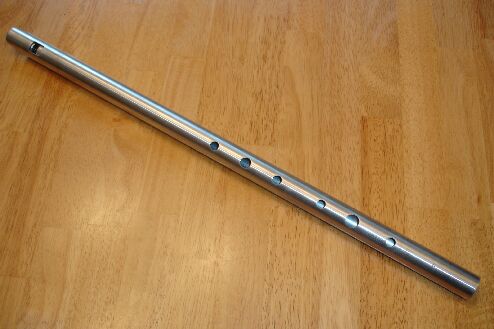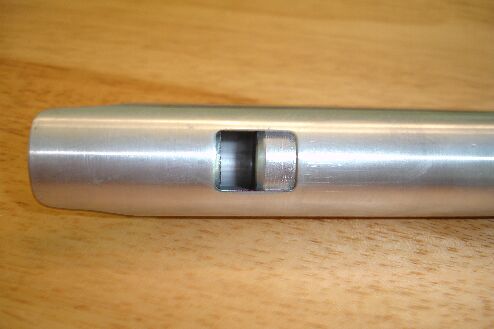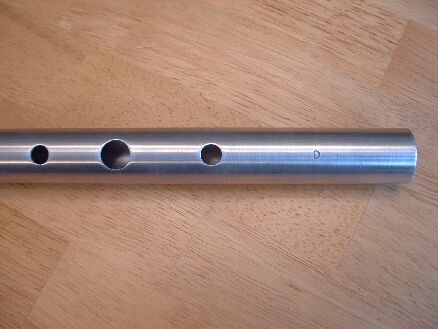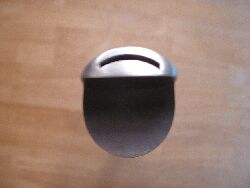Maker - Kerrywhistles (Phil Hardy) www.kerrywhistles.com
Material - Aluminum
Dimensions: Length - 22 15/16ths"
Distance between 1st and 3rd bottom holes - 3"
Diameter of 2nd hole from bottom - 1/2"
Bore - 7/8ths"
Weight - 7.5 oz
Price at time of review - 115 lbs direct from Maker, $187.00 US from distributor
Phil
Hardy has made many changes and improvements to his well known
Chieftain line of whistles over the years, but none perhaps as extreme
as the latest version, the V3 (which coincidently stands for Version
Three). As my main personal Low D of choice has been, and remains at
the time of this writing, a Chieftain OS (Old Style), I was excited to
get my hands on this whistle. When Phil announced that the first US
distributor to carry the V3 would be Lark in the Morning, I immediately
called and placed an order, although it seemed that I knew they would
be getting them before they did!
On a side note, a very informative and interesting video history of the Chieftain whistle can be viewed here on the Kerrywhistles website. It is entitled "Know your Chieftain" and is narrated by Phil Hardy himself.




On a side note, a very informative and interesting video history of the Chieftain whistle can be viewed here on the Kerrywhistles website. It is entitled "Know your Chieftain" and is narrated by Phil Hardy himself.




Appearance:
This whistle takes my favorite "tube with holes in it" zen aesthetic to
the extreme. The head/mouthpiece is just a continuance of the cylinder
shape of the body, with no demarcation of where the body stops and the
head starts. The head is the biggest change from the old Chieftains,
featuring a curved labium/blade, curved windway, and a rounded/sculpted
mouthpiece, compared to the old, square cut style. This
mouthpiece is the most comfortable of any low D I have yet played. The
end of the whistle tube has also been nicely rounded, indeed the blade
seems to be the only sharp edge on the instrument, and even that is
curved widthwise to fit inside the tube. This curved roundness,
along with the new shiny aluminum finish, give the whole whistle a kind
of modern, urban style/feel.
Tone: This is the one place where I felt the V3 let me down. Compared to the OS and NR (New Range) model Chieftains, the V3 is very breathy. To me it almost sounds like the tone of my OS covered by allot of breath/wind noise. Now this in and of itself is not a bad thing, more just a matter of personal preference. I personally like at least some breathiness in my low whistles, as I feel it is idiomatic to the instrument. But the V3 manages to have just a bit more than I like. I have played two different V3's and heard recordings of a few others, and this seems to be a consistent feature of all of them. It also seems that this breathiness is more evident to the player than a listener across the room. Now I again want to stress that this is just my personal preference, and I would not say that it is a "Bad", or negative problem/issue with the whistle itself. Others may like it. This whistle has a moderate amount of chiff. The second octave was not overly shrill, and the first octave, while not huge by any means, was pleasantly full. Much like other aluminum whistles, the V3 definitely sounds best when it is fully warmed up. Unfortunately, I found it took some effort to get it warmed up and then to keep it warmed up.
Volume: I would describe the volume of this whistle as being medium/moderate in comparison to other Low D's I have played. It is fairly well balanced between octaves, but would likely be lost in most session environments. Due to the aforementioned breathiness, this whistle can give the illusion of sounding muffled and quieter than it actually is.
Backpressure/air requirement: This was hard to peg, as unlike most other low whistles, the V3 responds to a wide range of air pressure. I thought it sounded best when blown harder, which consequently gave it a pretty high air requirement. This could be somewhat annoying , as I tended to run out of air a bit quicker than usual, but the benefit is that you can really push the notes around considerably without worrying about them breaking. This also makes it so you don't need to worry about breath support any where near as much as on other low whistles. It feels like all you have to do is just blow into it and there it is, no squawking, breaking or other such unpleasantness. Words like effortless come to mind. This whistle almost seems to play itself!
Responsiveness: Without a doubt, the best feature of the V3 is it's incredible responsiveness. Ornaments are crisp, fast and clear, and as previously mentioned, you can really play with the volume, shape and quality of each note using just your breath.
Clogging: I did not experience any clogging issues with this whistle once it was warmed up, but it would clog right away if I tried to blow the whistle when it was cold.
Tuning: This whistle did have a few small tuning issues that were not overly audible but did show up on the tuner. In the second octave, all the notes from the F# on up were around 20 cents flat. These of course can be pushed with breath support and/or velocity to somewhat compensate, but this can effect the tone. The C# was 20 cents flat as well, but the C natural was spot on using the standard OXXOOO fingering.
Sound clip: Si beag Si Mor
Summary: I really wanted to like this whistle, and for the most part I did. I just can't tell you how responsive and easy to play this whistle is. Unfortunately, I just personally didn't care for the tone. However, it definitely looks and especially plays like a professional, high quality whistle. Five holes!

Tone: This is the one place where I felt the V3 let me down. Compared to the OS and NR (New Range) model Chieftains, the V3 is very breathy. To me it almost sounds like the tone of my OS covered by allot of breath/wind noise. Now this in and of itself is not a bad thing, more just a matter of personal preference. I personally like at least some breathiness in my low whistles, as I feel it is idiomatic to the instrument. But the V3 manages to have just a bit more than I like. I have played two different V3's and heard recordings of a few others, and this seems to be a consistent feature of all of them. It also seems that this breathiness is more evident to the player than a listener across the room. Now I again want to stress that this is just my personal preference, and I would not say that it is a "Bad", or negative problem/issue with the whistle itself. Others may like it. This whistle has a moderate amount of chiff. The second octave was not overly shrill, and the first octave, while not huge by any means, was pleasantly full. Much like other aluminum whistles, the V3 definitely sounds best when it is fully warmed up. Unfortunately, I found it took some effort to get it warmed up and then to keep it warmed up.
Volume: I would describe the volume of this whistle as being medium/moderate in comparison to other Low D's I have played. It is fairly well balanced between octaves, but would likely be lost in most session environments. Due to the aforementioned breathiness, this whistle can give the illusion of sounding muffled and quieter than it actually is.
Backpressure/air requirement: This was hard to peg, as unlike most other low whistles, the V3 responds to a wide range of air pressure. I thought it sounded best when blown harder, which consequently gave it a pretty high air requirement. This could be somewhat annoying , as I tended to run out of air a bit quicker than usual, but the benefit is that you can really push the notes around considerably without worrying about them breaking. This also makes it so you don't need to worry about breath support any where near as much as on other low whistles. It feels like all you have to do is just blow into it and there it is, no squawking, breaking or other such unpleasantness. Words like effortless come to mind. This whistle almost seems to play itself!
Responsiveness: Without a doubt, the best feature of the V3 is it's incredible responsiveness. Ornaments are crisp, fast and clear, and as previously mentioned, you can really play with the volume, shape and quality of each note using just your breath.
Clogging: I did not experience any clogging issues with this whistle once it was warmed up, but it would clog right away if I tried to blow the whistle when it was cold.
Tuning: This whistle did have a few small tuning issues that were not overly audible but did show up on the tuner. In the second octave, all the notes from the F# on up were around 20 cents flat. These of course can be pushed with breath support and/or velocity to somewhat compensate, but this can effect the tone. The C# was 20 cents flat as well, but the C natural was spot on using the standard OXXOOO fingering.
Sound clip: Si beag Si Mor
Summary: I really wanted to like this whistle, and for the most part I did. I just can't tell you how responsive and easy to play this whistle is. Unfortunately, I just personally didn't care for the tone. However, it definitely looks and especially plays like a professional, high quality whistle. Five holes!